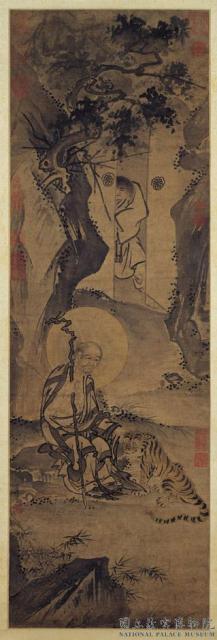明戴進畫羅漢 軸
推薦分享
資源連結
連結到原始資料 (您即將開啟新視窗離開本站)後設資料
- 資料識別:
- 故畫000409N000000000
- 資料類型:
- 類型:繪畫
- 型式:靜態圖像
- 著作者:
- 戴進
- 主題與關鍵字:
- 竹 虎 寺廟 佛道侍者 羅漢(應真、尊者)
- 出版者:
- 數位化執行單位:國立故宮博物院
- 格式:
- 本幅 113.9x36.7公分、全幅 61.3公分
- 關聯:
- 秘殿珠林續編﹝乾清宮﹞,頁142&*故宮書畫錄﹝卷五﹞,第三冊,頁296&*故宮書畫圖錄,第六冊,頁109-110&*1.李玉珉,〈明戴進畫羅漢〉,收入李玉珉主編,《羅漢畫》(臺北:國立故宮博物院,1990年初版),頁77-78。 2.〈明戴進畫羅漢〉,收入陳階晉、賴毓芝主編,《追索浙派》(臺北:國立故宮博物院,2008年初版一刷),頁170。 3.晉介塵,〈「戴進作品展」導讀 — 戴進畫羅漢〉,《故宮文物月刊》,第209期(2000年8月),頁89-90。 4.何嘉誼,《戴進道釋畫研究—以《達摩六祖圖》為核心》,國立中央大學藝術學研究所碩士論文,2007年。 &*明人畫山水,喜參以人物故實,戴進此作繪羅漢持杖靜坐堂前,左手徐伸伏虎,另有一侍童側身門後窺視,面露驚懼之色,而羅漢、虎則泰然自若。 觀其衣紋,率皆蠶頭鼠尾,形簡神具;人物面部描畫較細膩,生動傳神;山石皴法,出以大筆斧劈,水墨淋漓,挺健有力。全圖用筆迅速,氣勢渾成,筆墨有收有放,工寫之間,剛柔相濟,巧拙互用,應是他中年時期粗筆人物畫的一種風貌。&*Ming artists often included figures or stories in their landscapes. Here, Tai Chin painted a lohan holding a staff and seated quietly in front of a hall blocked from view. He calmly reaches out his right hand to tame the tiger at his feet. A servant boy, apparently frightened, peeps from behind the door. The drapery is rendered with lively “silkworm-head” and “rat-tail” strokes. The faces are even more detailed, conveying their spirit. The large “axe-cut” texture strokes of the cliffs are counterbalanced by the moist ink. The use of brush and ink is quick and energetic, though restrained in places. The effective balance between the two makes this an example of a kind of rough figure style from Tai Chin’s middle years.
- 管理權:
- 國立故宮博物院
授權聯絡窗口
- 國立故宮博物院圖像授權、出版授權、影音資料授權-申請流程說明
http://www.npm.gov.tw/zh-TW/Article.aspx?sNo=03003061






